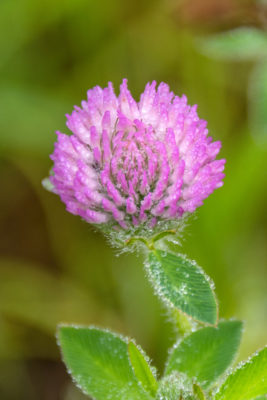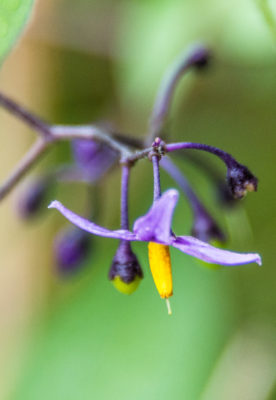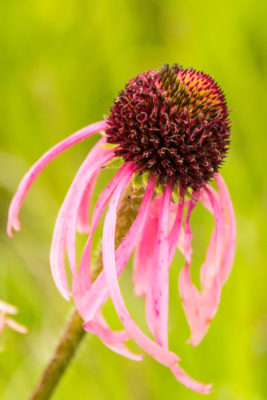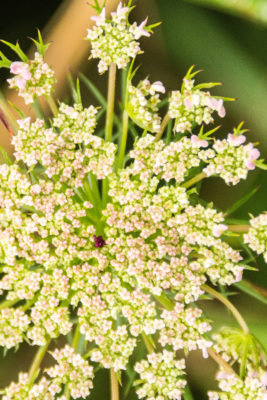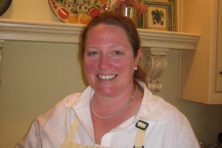On the Hunt for Door County Herbs
- Share
- Tweet
- Pin
- Share
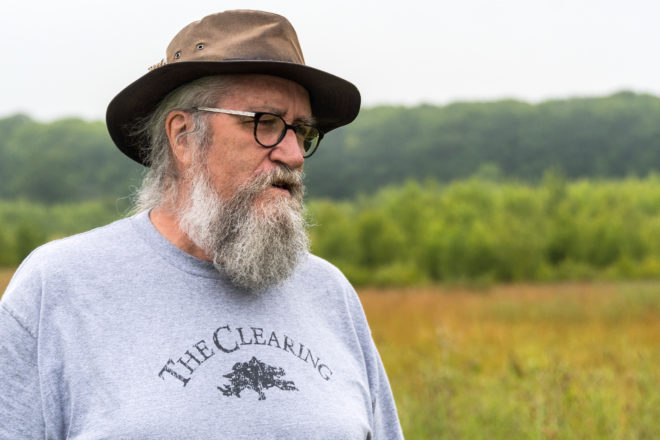
If you’ve ever seen David LaLuzerne meandering through Door County’s nature preserves and county parks, chances are he hasn’t taken much notice of you.
“I have a tendency to do that,” he explained. “Wherever I walk out I start to look around, what kind of herbs are growing now around here?”
On a gray, misty July day, we were barely out of the parking lot at the Oak Road Nature Preserve before LaLuzerne started identifying herbs peeking through the gravel drive while reciting their medicinal values.
The Ellison Bay resident and longtime pharmacist was preparing for his summer field herbs hike, the second in his five-part 2017 Herb Walk series. Through these outdoor excursions, LaLuzerne introduces fellow hikers to the abundance of local herbs in woodlands, fields and wetlands, and educates them on their historical, culinary and medicinal values.
It is a passion he has nurtured since his introduction to herbs during pharmacy school in the ’70s. His class was the last to have pharmacognosy – the study of medicinal drugs derived from natural sources like plants and sea life – as required coursework, and it set LaLuzerne on a path of incorporating homeopathic remedies into his life and career. He eventually opened an herb and vitamin shop called Green Earth, at one point operating three locations in the Madison area.
“I started to get into the whole idea of natural healing and what is healing all about,” LaLuzerne said. “To me, it’s about nourishing the body to heal itself, to restore a balance, and that’s really what herbs do…The issue that I have with healthcare is that it’s really about treating symptoms and you have to go to a doctor for that, to get a prescription, but there’s so much we should be able to do for ourselves. I feel like I try to help people learn about those things and one of the best ways to do that is through your food and stuff that you can do for yourself.”
- Red clover.
- St. John’s wort.
- Bittersweet nightshade.
- Echinacea.
- Yarrow leaf.
- Queen Anne’s lace. Photos by Len Villano.
His interest in educating people led to the launch of Herb TV Online (herbtvonline.com), an online resource for those interested in learning about oriental medicine, wildcrafting, herbalism and more. Five years ago he closed up shop in the Madison area and in 2015, he and his wife Lynn moved to Door County, where LaLuzerne has spent time finding and studying local herbs. He has taught classes at The Clearing, where interest in the topic inspired creation of his own Herb Walks.
The hike at the Oak Road Nature Preserve, a Door County Land Trust preserve located northeast of Carlsville, introduced us to the herbs growing in and alongside the trail on the vernal wetland portion of the land, east of Oak Road. Land trust guidelines prohibit visitors from collecting vegetation, wildlife and other material from preserves, so the hikes are purely visual, though LaLuzerne is quick to point out that herbs found on land trust preserves are likely to be found in your own backyard.
While the hikes are not long in distance, you can expect to make a stop every few feet as LaLuzerne points out nearby herbs and explains how to incorporate them into your everyday wellness routine. Today, he is excited to see echinacea in full bloom and as we walk the damp trails, he expounds on the value of the bergamot, Queen Anne’s lace, St. John’s wort and red clover we pass by.
LaLuzerne recommends three ways to use herbs for healing: as a tea/infusion, a tincture, or an additional ingredient in your regular meals (think salads).
“In many ways, the best way to use any herb is in your food, to incorporate the whole herb into your food somehow but the extract is better than the tea in terms of the medicinal value,” he said. “Of course teas can taste really good, too, and that’s beneficial.”
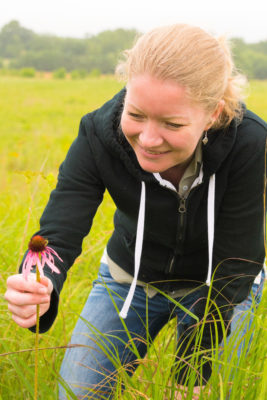
Pulse Arts, Lit and Entertainment Editor Alyssa Skiba admires an Echinacea plant in bloom at Oak Road Nature Preserve. Photo by Len Villano.
To make a tincture – an alcoholic extract of a plant – LaLuzerne chops up the plant material, places it in a glass jar, and covers the material with either brandy or vodka. He gives the mixture a daily shake over the course of two to six weeks, depending on the material.
“If it’s flowers and leaves, usually two weeks is enough to extract but if you have a root or bark, which can be used in a lot of cases, you would chop it up and then let it extract for at least six weeks because it’s denser material, it’s harder to make a good extraction,” he said.
Tinctures are taken in very small doses and can be diluted in water or juice before drinking them (do your research to determine best dosage). As for making tea, the amount of plant material used depends on whether the plant is fresh or dried.
“If you’re using a fresh plant, you probably want a good couple tablespoons per cup,” LaLuzerne said. “If you dry it, you can use less, maybe one or two teaspoons.”
As for incorporating herbs into meals, LaLuzerne recommends a variety of preparations: boiled, roasted or raw in a salad. When it comes down to it, the most important part is consumption.
“Ultimately I think the body is what heals itself and you just gotta give it the nutrients it needs to do that,” he said. “That’s why I like herbs.”
For those interested in getting started, LaLuzerne recommends two guides: Newcomb’s Wildflower Guide by Lawrence Newcomb, and A Field Guide to Medicinal Plants and Herbs: Eastern and Central North America by Steven Foster and James A. Duke.
Three hikes remain in David LaLuzerne’s schedule. They are: Aug. 12, wetland herbs, Reiboldt’s Creek at Moonlight Bay; Sept. 16, mushrooms, Mink River Trail; Oct. 14, herbs in the neighborhood, LaLuzerne residence (12030 Garrett Bay Road, Ellison Bay). All herb walks are held on Saturdays from 1 – 3pm. Hikes are $5. For more information, email LaLuzerne at [email protected].

